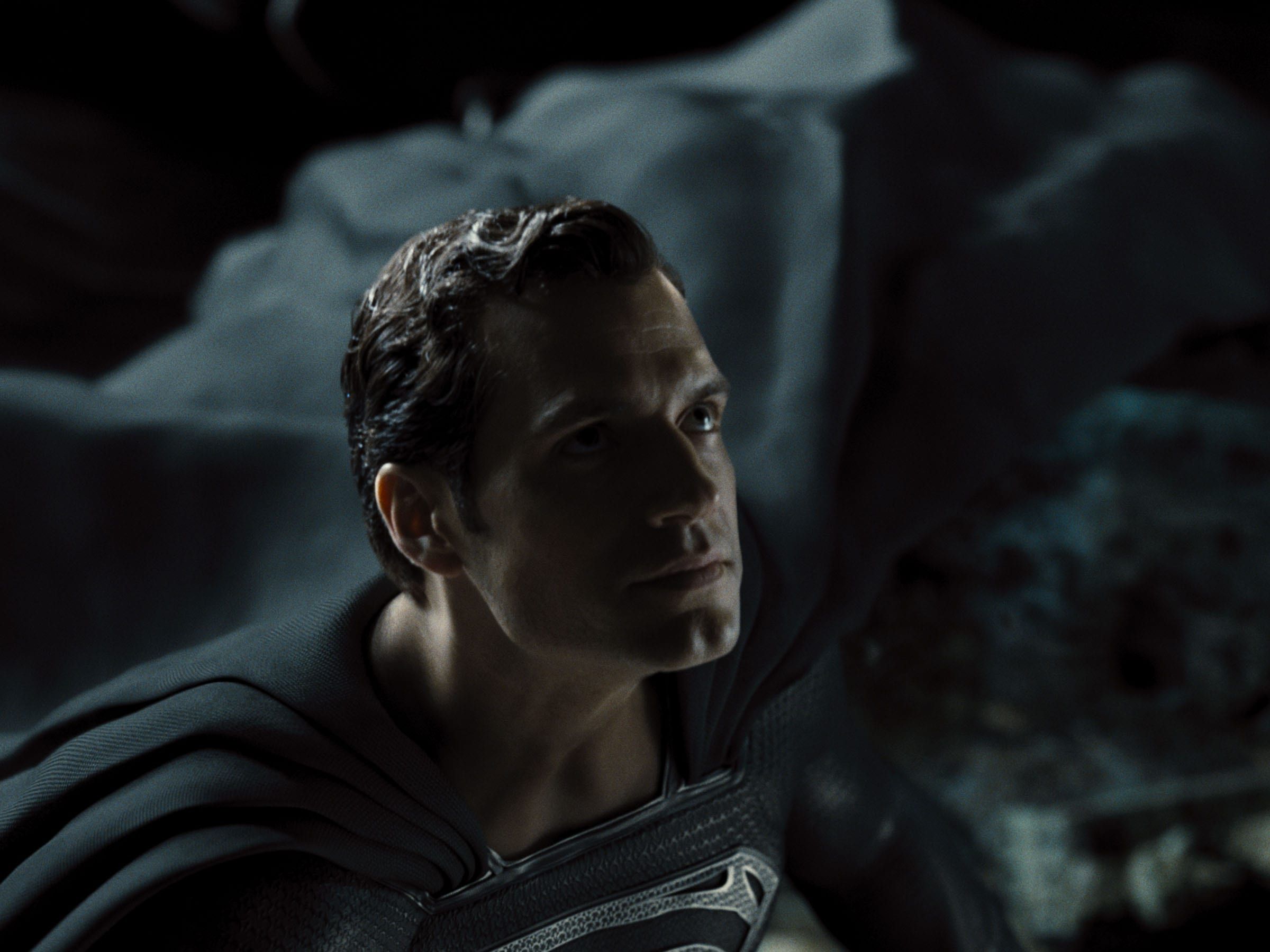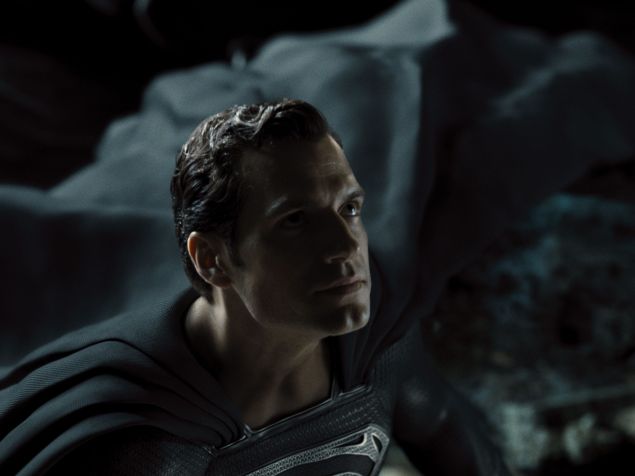
Zack Snyder’s Justice League mostly buckles under its own self-seriousness, especially when it comes to its villains. Pictured: Superman (Henry Cavill) Warner Bros. Pictures
The 2017 Justice League was a studio debacle, the result of dueling creative visions and more backstabbing than a performance of Julius Caesar. Zack Snyder, who made predecessors Man of Steel and Batman v Superman, was the film’s credited director, but he wasn’t largely responsible for what made it to the screen. That distinction belongs to Avengers helmer Joss Whedon, who punched-up the script, oversaw the many reshoots, and then took over entirely once Snyder left the project after a family tragedy. It’s hard not to see why diehard fans view Zack Snyder’s Justice League — or “The Snyder Cut†— as a wrong being righted, regardless of how the online hubbub has often played out.
Four years and $70 million in reshoots and post-production later, and Snyder’s 214 minute assembly has now taken the form of a 4 hour and 2 minute behemoth, all set for a March 18th release on HBO Max and other streaming platforms worldwide. The result is… well, it’s different enough from the 2017 film to justify its existence, if only as an artistic curio. The two versions have 5 or 7 scenes in common at best, and the 4-hour cut, while less humorous, is more technically competent. The locations feel more tangible — the film is generally less of an eyesore — and Ray Fisher’s Cyborg, who was sidelined in the theatrical cut, now has a leading role. The broad strokes, however, are largely the same, and the film’s length feels inexcusable by the time the end credits have mercifully rolled.
The most striking difference is Snyder’s mythic approach to these characters, a choice which further cements him as a stunning visualist regardless of his narrative instincts. The film’s first hour comprises introductions and re-introductions (Jason Momoa’s Aquaman gets about four), but the gargantuan runtime allows for a series of slow-motion tableaus, captured with the reverence of a sculptor in ancient Greece. It’s the first time this approach has really worked in these films — one imagines it might feel like watching gods in motion when viewed on an IMAX screen — but the reason it works is that these living dioramas are largely divorced from the central plot. They aren’t a distraction for once, but a dreamy prelude, to a film that doesn’t really get going for the first hour and a half.
|
ZACK SNYDER’S JUSTICE LEAGUE ★1/2 |
But there’s also a problem with this mythic framing. While it works when applied to, say, Aquaman sauntering across a pier while being engulfed by ocean waves, or Wonder Woman (Gal Gadot) thwarting a cult of nihilistic bombers, this visual aesthetic is also indiscriminate, as has often been the case in Snyder’s films. A shell casing falling to the ground during a fight scene is shot with as much aplomb as the death of Superman, and the approach borders on self-parody when the film cuts from Steppenwolf’s glistening armor to a close up of a Gillette Fusion® Proglide® Razor With Flexball Technology™ being rinsed in slow-motion under shimmering tap water.
Superman’s death in Batman v Superman — re-created in this film’s opening, and framed as its inciting incident — doesn’t have nearly as much narrative impact as you might expect. A strange part of watching Zack Snyder’s Justice League is retroactively connecting the dots, and realizing which elements of the theatrical cut were added to fix things that didn’t quite work. For instance, the theatrical version opens with an on-the-ground look at a world without Superman, while the Snyder Cut features no such perspective.
In this film, Superman’s scream, in the moment of his death, ripples across the globe and awakens three Mother Boxes (the film’s hidden alien MacGuffins), which summon the villain Steppenwolf (Ciaran Hinds). It’s actually pretty cool, but beyond that, Superman’s death doesn’t really seem to affect the plot or characters all that much. We’re shown hints of withered flowers in Metropolis, a few brief shots of Lois Lane (Amy Adams) and Martha Kent (Diane Lane) in mourning, and a scene between them that leads to a bizarre fake-out which undercuts a moment of genuine drama. But apart from Batman (Ben Affleck) mentioning him once, Superman is essentially a non-presence until well over 2 hours into the film.
SEE ALSO: What ‘Zack Snyder’s Justice League’ Actually Does Right
The theatrical reshoots were most apparent during a scene in Batman’s hangar, when the heroes debated the ethics of resurrecting Superman. It was garishly lit, and the actors clearly weren’t standing in the same physical space, but it feels necessary in hindsight. There’s no real debate about it in the Snyder Cut, and no real sense that the heroes even need him to begin with. In fact, there’s very little friction between the main characters at all, which isn’t a foundation that can support the weight of a 4-hour film.
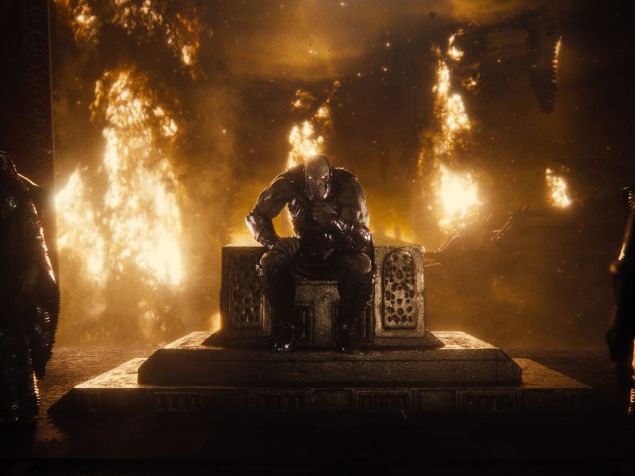

The film complicates the story of Darkseid (Ray Porter) with a late-in-the-game realization that makes him look like a doofus. Warner Bros. Pictures
Much of that dead weight is specifically owed to the film’s main villains. Steppenwolf arrives to collect the Boxes as he did before, and he looks bigger and shinier, but he’s somehow even less compelling. The one thing the character had going for him theatrically was the ancient flashback in which his initial conquest failed. His return to Earth for a second go-around made sense, as it evoked the barest motive of redemption. The Snyder Cut, however, is so over-eager to introduce comic book lore and sequel set-ups that it gives Steppenwolf even less to work with.
The failed flashback conquest is now longer and more indulgent, but it belongs to Darkseid (Ray Porter), Steppenwolf’s hulking, brutish master, and the intended Final Boss for the canceled sequels. Meanwhile, Steppenwolf’s motivation is now redemption for some unrelated, unseen failure which barely warrants a passing mention. What’s more, the film complicates even Darkseid’s story, with a late-in-the-game realization that makes him look like a doofus, and the sudden addition of a comic element that renders the Mother Box plot entirely obsolete — but the film follows through with it anyway. There’s also an emissary, DeSaad (Peter Guinness) who facilitates all Darkseid-Steppenwolf communiqué, but the three grey goons all look and sound largely identical (their monotonous cadence, if not their actual voices).
In spite of the ballooning post-production budget, the visual effects don’t always seem complete. You seldom get a good look at Steppenwolf’s henchmen, the Parademons, but so much of the film is awash in darkness that the obfuscation feels intentional. Your mileage may vary. The grim palette works when the characters are presented as disconnected from humanity, but when they each find reasons to fight for it, their trajectories aren’t reflected or dramatized in any meaningful aesthetic way. The words they speak may change, but the film doesn’t change to match them.
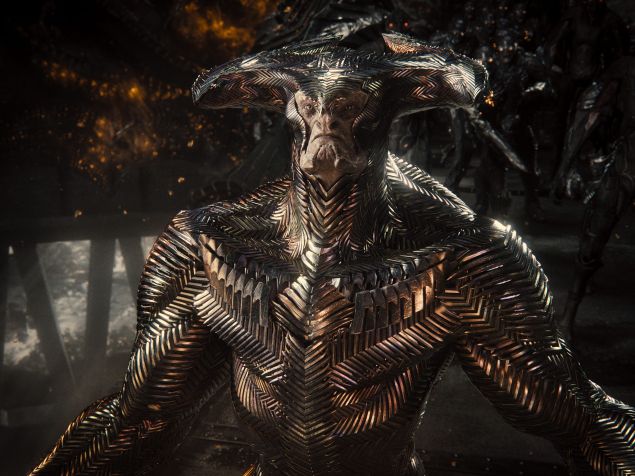

Steppenwolf’s (Ciarán Hinds) motivation is now redemption for some unrelated, unseen failure which barely warrants a passing mention. Warner Bros. Pictures
Ironically, that first hour of disconnected tableaus features some of the film’s most competent storytelling. The music is overt and on-the-nose, but it at least attempts to weave thematic webs for its characters (namely, Batman, Aquaman and Wonder Woman, since Fisher’s Cyborg and Ezra Miller’s Flash don’t really feature in this part of the film). “There Is a Kingdom†by Nick Cave & The Bad Seeds feels like the most obvious needle drop for Aquaman, a character at odds with his royal lineage — “There is a kingdom / There is a king / And he lives without / And he lives within†— but it fits the first hour’s moody music video M.O., and is marginally more subtle than having the characters simply mention their dilemmas outright (here’s looking at you, Marvel).
SEE ALSO: How ‘Zack Snyder’s Justice League’ Went From Myth to Mandate
Composer Thomas Holkenborg/Junkie XL creates an especially compelling theme for Wonder Woman, who seems to wrestle with the distance she’s put between herself and her Amazonian sisters. It’s a vocal arrangement of her now famous percussion-heavy electric guitar riff from Batman v Superman, echoing like some reminder in the distance, or in her memory — but for every scene where it works, there are two more where it doesn’t. Like the film’s visual tricks, it’s applied indiscriminately, to the point that it loses meaning. It never evolves, and it never guides her evolution, because there’s so little evolution to guide despite the runtime being twice as long.
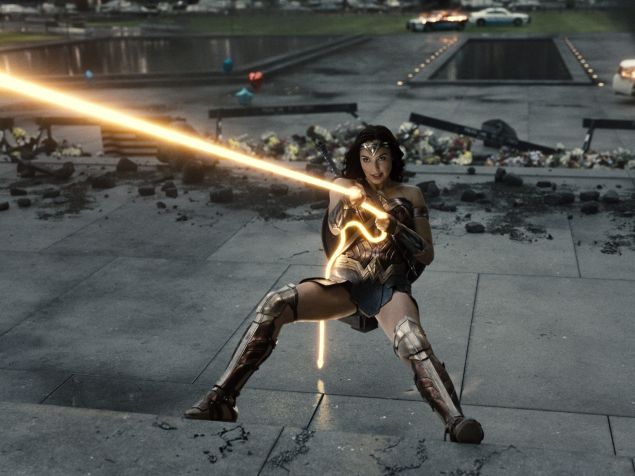

Wonder Woman (Gal Gadot) Warner Bros. Pictures
The film is divided into seven arbitrary chapters, each with its own title card, but it’s a really 3-part story. The first hour is all the aforementioned setup, the last hour is the climax (and a dreary series of extended epilogues, which really hammer home the exhaustion). But the middle two hours are where it most feels like an actual story. It practically starts afresh with the introductions of Cyborg and The Flash, the only characters who seem to get hurt, physically or emotionally. They also have the most dramatic meat, and are most vital to the finale. It’s hard not to wonder why this wasn’t their story to begin with.
The Flash/Barry Allen is played as lighthearted and goofy, and his romantic rendezvous with Iris West (Kiersey Clemons) comes and goes in the blink of an eye — it’s pretty much all in the trailers, and feels entirely like sequel setup. But he at least has some semblance of lived history that guides him, between an imprisoned father (Billy Crudup) and the limitations he sets on his own abilities, which he’s eventually forced to break in inventive fashion. There’s something quite wonderful about the way he traipses through space. It’s almost like a dance.
However, the film’s biggest surprise is Cyborg/Victor Stone, a former college football player who gets in a near-fatal accident, and is Robocop’d back to life by his father Silas (Joe Morton) using one of the alien Mother Boxes.
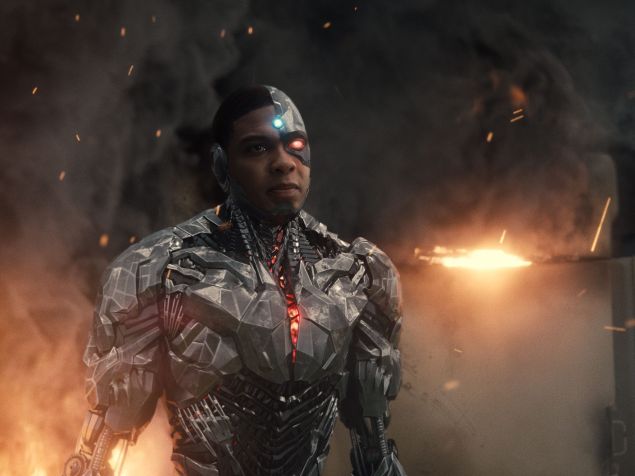

While the film frequently stands on the precipice of a great Cyborg (Ray Fisher) story, it stops frustratingly short. Warner Bros. Pictures
Cyborg, admittedly, suffers from the film’s nagging thematic flaws. His Mother Box origin serves a plot function, but his alien nature is rarely contrasted with Steppenwolf’s similarly created Parademons. However, a huge centerpiece in the film’s middle two hours is Victor’s rocky relationship with his father, whom he blames for his mother’s death in the accident which maimed him. The aloof bionic man sees himself as a monster, and so fighting alongside the Justice League is his opportunity to re-enter the world. The heroes often cross paths with Silas, who leads an important scientific facility, and so there are numerous opportunities for father and son to either reconcile, or to share silent glances of mutual understanding as they protect the people around them.
Some of these exchanges are genuinely moving, and they allow Fisher some nuanced dramatic work (he’s a treat to watch, down to his body language). However, while the film frequently stands on the precipice of a great Cyborg story, it stops frustratingly short. It explores his human past in far more detail than the 2017 film, including a college incident involving ethical hacking. His powers expand on this thread, giving him unlimited access to practically every technology (which he uses to help people down on their luck, albeit from the shadows). But despite setting up dilemmas about the complex responsibility these powers entail, the film sidelines them in favor of CGI mayhem.
Compared to the theatrical film, Snyder has much more of an interest in Cyborg’s psychology (and his physiology, and the ways they intersect). He often presents Cyborg interfacing with machines in the form virtual reality, with Victor’s self-image walking through dismal dreamscapes, and changing in appearance to reflect his evolving relationship with his body. And sure, the depiction of financial hacking is a little silly — digital stacks of money and a bear and bull fighting are oddly literal choices in a dream-realm! — but you can’t fault the film for trying to have a little fun. Boy, does it need some.
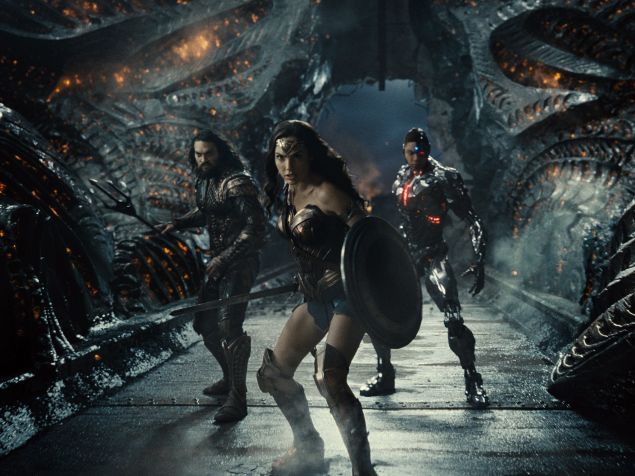

Aquaman (Jason Momoa), Wonder Woman (Gal Gadot) and Cyborg (Ray Fisher) Warner Bros. Pictures
The Flash provides bits of levity, Alfred (Jeremy Irons) gets a few quips in too, and Aquaman’s enthusiastic YEAHs and AWLRIGHTs are thankfully intact. But the film mostly buckles under its overwrought self-seriousness, especially when it comes to its villains. Darkseid becomes a major enough specter to sideline Steppenwolf, but not so major that he actually steps in and makes the conflict interesting. Darkseid’s home world of Apokolips, while glimpsed only briefly, is unimaginative in its conception, and there’s only a single moment — a fleeting, sequel-bait premonition underwater — where he seems exciting or intimidating.
Of course, a Snyder-helmed sequel is unlikely to happen, but the film practically begs hardcore fans to start another online campaign with its recently re-shot material. The runtime is inelegantly inflated by this new scene — or rather, two scenes back to back. One involves a visit from a new character to set up future stories, while the other, teased in the recent trailer, unfolds in a post-apocalyptic hellscape, like Batman’s vision from Batman v Superman. The world it hints at is far more interesting than the film’s personality-free Gotham and Metropolis, but the way the scene plays out is mind-boggling, between stretches of meaningless dialog, Jared Leto’s poor Heath Ledger impression, and the fact that it has zero connection to the story. It’s quite blatantly concept footage for a potential next installment, and it’s incredibly draining to sit through.
The action might feel like a respite if Snyder’s approach is to your liking. It often fluctuates between slow-motion and fast-forward — a happy medium is rare — but the film’s 1.43:1 frame is often too busy for any sort of visual clarity. The CGI feels weightless and unfinished, and the non-Cyborg characters are slowly rendered incapable of anchoring the story. Aquaman’s arc wraps-up halfway through. Wonder Woman’s barely begins. Even Batman has little to do beyond assembling the team, though he’s at least made to look insignificant in Superman’s presence without looking silly as well (the way he did in the theatrical version). Meanwhile Superman, with his late arrival, is merely given a compressed retread of his gloomy, misanthropic arc from both previous films, down to a meaningless wardrobe change and a flight of fancy filmed with unearned gravitas, before he shows up to the finale and diffuses what little tension it has.
Zack Snyder’s Justice League may feature altered scenes from its chopped-up counterpart, but it’s unlikely to play any differently to general audiences — apart from feeling like more of a slog. Its mere existence guarantees that someone, somewhere will be satisfied, but the film’s improvements are hardly enough to fix what was, now quite apparently, a flawed endeavor from the start.
Zack Snyder’s Justice League debuts on HBO Max on March 18.
Observer Reviews are regular assessments of new and noteworthy cinema.

